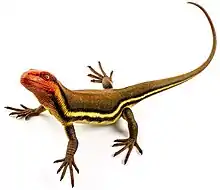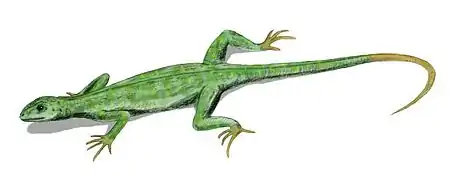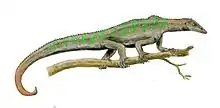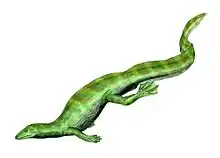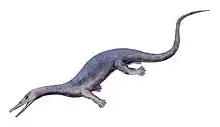Araeoscelis
Araeoscelis is an extinct genus of reptile, and one of the earliest diapsids. Fossils have been found in the Nocona, Arroyo and Waggoner Ranch Formations in Texas, dating to the Early Permian. Two species have been described, A. casei and A. gracilis.[1]
| Araeoscelis | |
|---|---|
 | |
| Life restoration | |
| Scientific classification | |
| Kingdom: | Animalia |
| Phylum: | Chordata |
| Class: | Reptilia |
| Order: | †Araeoscelidia |
| Family: | †Araeoscelidae |
| Genus: | †Araeoscelis Williston 1910 |
| Type species | |
| Araeoscelis gracilis Williston 1910 | |
| Species | |
| |
| Synonyms | |
| |
Description

Araeoscelis was around 60 centimetres (2.0 ft) long, and superficially resembled a modern lizard. It differed from earlier forms, such as Petrolacosaurus, in that its teeth were larger and blunter; possibly they were used for cracking insect carapaces.[2]
Unlike its close relatives, which exhibit the two pairs of skull openings characteristic of diapsids, in Araeoscelis the lower pair of temporal fenestrae were closed with bone, resulting in a euryapsid condition. This would have made the skull more solid, presumably allowing a more powerful bite.[2]
Ichnology
Footprints found in Nova Scotia have been attributed to Araeoscelis or a close relative.[1]
References
- Dixon, Dougal (2015). The Complete Illustrated Encyclopedia of Dinosaurs. London: Hermes House.
- Palmer, D., ed. (1999). The Marshall Illustrated Encyclopedia of Dinosaurs and Prehistoric Animals. London: Marshall Editions. p. 82. ISBN 1-84028-152-9.
Further reading
- Carroll, Robert L. (1988). Vertebrate Paleontology and Evolution. New York: W.H. Freeman and Co.
- Benton, Michael J. (2000). Vertebrate Paleontology (2nd ed.). Oxford: Blackwell Science.
- Simon and Schuster (1999). The Simon & Schuster Encyclopedia of Dinosaurs and Prehistoric Creatures (1st ed.). Great Britain: Marshall Publishing. ISBN 0-684-86411-8.

